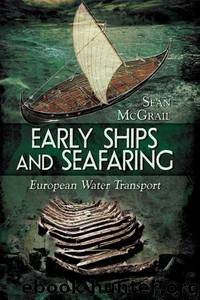Early Ships and Seafaring: Water Transport within Europe by Sean McGrail

Author:Sean McGrail [McGrail, Sean]
Language: eng
Format: epub
Tags: HISTORY / Ancient / General
ISBN: 9781473847774
Publisher: Pen and Sword
Published: 2014-11-29T22:00:00+00:00
Fig. 2.12. Visibility of the Mediterranean coastfrom sea level. Ships in the shaded areas would be out-of-sight of land. (after Henkel)
It is possible that, from necessity, simple navigational techniques were developed and used in poor weather, when land was not visible: for example, estimating directions from the Great Bear constellation at night (‘north’), and from the sun’s meridian passage (‘noon’) in daylight (‘south’). Homer, Strabo and Pliny recognised the Phoenicians as ‘master navigators’: they were said to be the first to use astronomical knowledge, gained from the Chaldeans, to navigate at sea. Moreover, they were acknowledged to have been the first in the Mediterranean to recognise that the constellation Ursa Minor orbited the celestial North Pole in a tighter circle than did Ursa Major, and so could be used as a more precise indication of north. Lucan (Bel. Civ. 8: 177-181), of the first century AD, states that the zenith altitude of selected stars was measured against the mast (probably in harbour?) giving some measure of latitude which could then be compared with similar estimates made elsewhere.
With the sky obscured, directions could be estimated relative to the wind or to the swell. In poor visibility, the sounding lead was used to detect decreasing depths of water, a warning of land ahead: Herodotus (2.5) notes that such was the practice when approaching the Nile delta from the north. Many such leads have been found in inshore waters, the earliest dateable one being from a wreck of 500 – 480 BC.
Such informal, environmental methods (‘navigation without instruments’) seem to have prevailed, until the sixth century AD when Arab seamen brought to the Mediterranean navigational ideas and techniques that they had developed from Greek land-surveying methods. In the ninth century AD the Arab navigator al-Khwarizmi described a staff which was used at sea to measure star altitudes: this ‘prototype kamal’ may have been developed from the Greek dioptra, a device for measuring angles. Thus the shift to mathematical navigation using instruments and charts continued, reaching its culmination in the thirteenth and fourteenth centuries.
In early times, pilotage and navigational lore was handed on orally, but in the fourth century BC, written sailing directions (periploi) for coastal passages began to be compiled. These were not only for passages within the Mediterranean, but also for selected passages outside. For example, along the coast of north-west Africa, and two routes southwards from the Egyptian Red Sea harbour of Myos Hormos: one around the Horn of Africa to Zanzibar, and another, beyond the Persian Gulf and on to India. This set of sailing directions, the Periplus Maris Erythraei, written in Greek in about AD 50, also included information on trading prospects and comments on the economic potential of coastal territories.
By the mid-first millennium BC, Phoenicians had sailed the Atlantic coast of north-west Africa, and traded along the Atlantic coast of south-west Iberia. In c. 320 BC, Pytheas of Massilia (Marseille) undertook what was probably a scientific exploration of the European Atlantic coast, possibly going as far north as the Faroes and the Baltic.
Download
This site does not store any files on its server. We only index and link to content provided by other sites. Please contact the content providers to delete copyright contents if any and email us, we'll remove relevant links or contents immediately.
| Automotive | Engineering |
| Transportation |
Small Unmanned Fixed-wing Aircraft Design by Andrew J. Keane Andras Sobester James P. Scanlan & András Sóbester & James P. Scanlan(32763)
Navigation and Map Reading by K Andrew(5131)
Endurance: Shackleton's Incredible Voyage by Alfred Lansing(4715)
And the Band Played On by Randy Shilts(2163)
The Box by Marc Levinson(1962)
Top 10 Prague (EYEWITNESS TOP 10 TRAVEL GUIDES) by DK(1953)
Wild Ride by Adam Lashinsky(1950)
The Race for Hitler's X-Planes: Britain's 1945 Mission to Capture Secret Luftwaffe Technology by John Christopher(1836)
The One Percenter Encyclopedia by Bill Hayes(1810)
Trans-Siberian Railway by Lonely Planet(1725)
Girls Auto Clinic Glove Box Guide by Patrice Banks(1705)
Bligh by Rob Mundle(1675)
Looking for a Ship by John McPhee(1650)
Good with Words by Patrick Barry(1638)
Batavia's Graveyard by Mike Dash(1629)
TWA 800 by Jack Cashill(1625)
Fighting Hitler's Jets: The Extraordinary Story of the American Airmen Who Beat the Luftwaffe and Defeated Nazi Germany by Robert F. Dorr(1610)
Troubleshooting and Repair of Diesel Engines by Paul Dempsey(1576)
Ticket to Ride by Tom Chesshyre(1564)
